Creating a travel booking app involves multiple steps, from initial planning and design to development and rigorous testing.
In this guide, I will walk you through the entire process of building a travel booking app that meets travelers’ needs and stands out in a competitive market.
By focusing on user-friendly design, seamless functionality, and robust performance, we can create an app that provides an exceptional user experience.
Whether they are seasoned developers or new to app creation, this guide will help them navigate the complexities of building a top-notch travel booking app. For expert assistance, explore our mobile application development services to bring your vision to life with professional guidance and support.
Let’s start writing for the app development process for a travel booking app.
Step 1: Define Your App’s Purpose and Features
First, we must define the app’s purpose and identify the key features that will make it valuable to users. A white-label travel booking app should provide a seamless experience for users to search for, book, and manage their travel plans.
Key Features:
- Search and Filter: Allow users to search for flights, hotels, car rentals, and other travel services. Provide filters to refine search results based on criteria like price, location, and ratings.
- Booking Management: Enable users to book and manage their travel itineraries within the app. Include options for cancellations and modifications.
- Payment Integration: Integrate secure payment gateways to facilitate transactions.
- User Profiles: Users can create profiles to save their preferences and booking history.
- Notifications: Send real-time notifications about booking confirmations, changes, and special offers.
Step 2: Conduct Market Research
We must conduct market research to understand the needs and preferences of our target audience. Analyze competitor apps to identify their strengths and weaknesses, and use this information to improve our app.
Market Insights:
- According to Statista, the online travel booking market is expected to reach $983 billion by 2027.
- A survey by Travelport found that 81% of travelers prefer to book their trips through ready-made mobile apps for convenience and ease of use.
Step 3: Design the User Interface (UI)
Designing an intuitive and visually appealing UI is crucial for user satisfaction. We must create wireframes and mockups to visualize the app’s layout and functionality.
UI Design Tips:
- Simplicity: Keep the design simple and easy to navigate.
- Consistency: Consistency in design elements like colors, fonts, and icons.
- Responsiveness: Ensure the app works well on different screen sizes and devices.
Here is a sample wireframe for a travel booking app:
Step 4: Develop the App
With the design in place, we move on to the development phase. We must choose the technology stack and frameworks to build a robust and scalable app.
Technology Stack:
- Front-End: React Native or Flutter for cross-platform development.
- Back-End: Node.js with Express for the server-side logic.
- Database: MongoDB or PostgreSQL for data storage.
- Payment Gateway: Stripe or PayPal for secure payments.
Step 5: Implement Key Features
We will implement the key features identified in Step 1. Let’s break down each feature:
Search and Filter:
- Flight Search: Integrate with flight APIs like Skyscanner or Amadeus to provide real-time flight information.
- Hotel Search: Use APIs from Booking.com or Airbnb to fetch hotel listings.
- Car Rentals: Integrate with car rental services like Hertz or Enterprise.
Booking Management:
- Itinerary Management: Allow users to view and manage their bookings.
- Cancellations and Modifications: Provide options to cancel or modify bookings.
Payment Integration:
- Secure Transactions: Use SSL encryption for secure payments.
- Multiple Payment Options: Support credit cards, debit cards, and digital wallets.
User Profiles:
- Profile Creation: Allow users to create and edit profiles.
- Preferences and History: Save user preferences and booking history for a personalized experience.
Notifications:
- Real-Time Updates: Send push notifications for booking confirmations and changes.
- Special Offers: Notify users about discounts and promotions.
Step 6: Test the App
Testing is a critical phase in the app development process. Before launching the app, we must thoroughly test it to identify and fix any issues.
Testing Types:
- Unit Testing: Test individual components and functions.
- Integration Testing: Ensure that different components work together seamlessly.
- User Acceptance Testing (UAT): Get feedback from real users to identify usability issues.
- Performance Testing: Test the app’s performance under different conditions.
Step 7: Launch the App
We can proceed with the launch once we have tested the app and ensured it is ready for release. We must submit the app to the relevant app stores (Apple App Store and Google Play Store) and promote it to reach our target audience.
App Store Submission:
- Prepare App Store Listing: Create an appealing app store listing with screenshots, descriptions, and keywords.
- Follow Guidelines: Ensure the app meets the guidelines of the app stores.
- Submit for Review: Submit the app for review and address any feedback from the app store reviewers.
Step 8: Promote and Market the App
Effective promotion and marketing are essential for the success of our travel booking app. We need to create a marketing strategy to attract users and generate downloads.
Marketing Strategies:
- Social Media Marketing: Promote the app on social media platforms like Facebook, Instagram, and Twitter.
- Influencer Partnerships: Collaborate with travel influencers to reach a wider audience.
- Content Marketing: Create blog posts and videos about travel tips and experiences to attract users.
- Email Marketing: Send promotional emails to potential users with special offers and discounts.
Step 9: Gather User Feedback and Iterate
After the app is launched, we need to gather user feedback and continuously improve the app. We should monitor user reviews and ratings and address any issues promptly.
User Feedback:
- In-App Surveys: Include surveys within the app to gather user feedback.
- App Store Reviews: Monitor reviews and respond to user concerns.
- Analytics: Use analytics tools to track user behavior and identify areas for improvement.
Real-World Impact: Case Studies
Let’s examine a few case studies of successful travel booking apps to understand their strategies and outcomes:
- Booking.com: Booking.com is a leading travel booking app that offers a wide range of accommodations and travel services. They use AI and machine learning to personalize user experiences and provide relevant recommendations. Their user-friendly interface and extensive inventory have contributed to their success, with over 1.5 million room nights booked daily.
- Expedia: Expedia provides a comprehensive travel booking platform that includes flights, hotels, car rentals, and vacation packages. They have integrated multiple payment options and offer exclusive deals to app users. Their effective marketing strategies, including partnerships with airlines and hotels, have helped them maintain a strong market presence.
- Hopper: Hopper is known for its predictive analytics, which helps users find the best time to book flights and hotels. They use historical data to forecast price trends and notify users when prices are expected to drop. Hopper’s innovative approach has led to significant growth, with over 50 million downloads.
Conclusion
Building a travel booking app involves careful planning, design, development, and testing. By following these steps, we can create an app that meets the needs of travelers and stands out in the market.
From defining critical features to promoting the app and gathering user feedback, each phase plays a crucial role in the app’s success. As the travel industry evolves, leveraging technology and user insights will be vital to staying competitive and delivering a superior user experience.
Also Read Interesting articles at Disboard.co.uk













